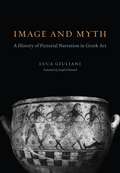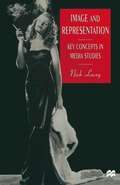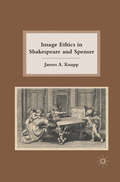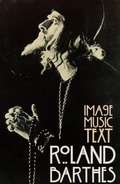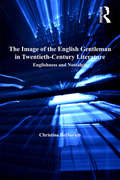- Table View
- List View
Image and Myth: A History of Pictorial Narration in Greek Art
by Luca GiulianiOn museum visits, we pass by beautiful, well-preserved vases from ancient Greece—but how often do we understand what the images on them depict? In Image and Myth, Luca Giuliani tells the stories behind the pictures, exploring how artists of antiquity had to determine which motifs or historical and mythic events to use to tell an underlying story while also keeping in mind the tastes and expectations of paying clients. Covering the range of Greek style and its growth between the early Archaic and Hellenistic periods, Giuliani describes the intellectual, social, and artistic contexts in which the images were created. He reveals that developments in Greek vase painting were driven as much by the times as they were by tradition—the better-known the story, the less leeway the artists had in interpreting it. As literary culture transformed from an oral tradition, in which stories were always in flux, to the stability of written texts, the images produced by artists eventually became nothing more than illustrations of canonical works. At once a work of cultural and art history, Image and Myth builds a new way of understanding the visual culture of ancient Greece.
Image and Myth: A History of Pictorial Narration in Greek Art
by Luca GiulianiOn museum visits, we pass by beautiful, well-preserved vases from ancient Greece—but how often do we understand what the images on them depict? In Image and Myth, Luca Giuliani tells the stories behind the pictures, exploring how artists of antiquity had to determine which motifs or historical and mythic events to use to tell an underlying story while also keeping in mind the tastes and expectations of paying clients. Covering the range of Greek style and its growth between the early Archaic and Hellenistic periods, Giuliani describes the intellectual, social, and artistic contexts in which the images were created. He reveals that developments in Greek vase painting were driven as much by the times as they were by tradition—the better-known the story, the less leeway the artists had in interpreting it. As literary culture transformed from an oral tradition, in which stories were always in flux, to the stability of written texts, the images produced by artists eventually became nothing more than illustrations of canonical works. At once a work of cultural and art history, Image and Myth builds a new way of understanding the visual culture of ancient Greece.
Image and Myth: A History of Pictorial Narration in Greek Art
by Luca GiulianiOn museum visits, we pass by beautiful, well-preserved vases from ancient Greece—but how often do we understand what the images on them depict? In Image and Myth, Luca Giuliani tells the stories behind the pictures, exploring how artists of antiquity had to determine which motifs or historical and mythic events to use to tell an underlying story while also keeping in mind the tastes and expectations of paying clients. Covering the range of Greek style and its growth between the early Archaic and Hellenistic periods, Giuliani describes the intellectual, social, and artistic contexts in which the images were created. He reveals that developments in Greek vase painting were driven as much by the times as they were by tradition—the better-known the story, the less leeway the artists had in interpreting it. As literary culture transformed from an oral tradition, in which stories were always in flux, to the stability of written texts, the images produced by artists eventually became nothing more than illustrations of canonical works. At once a work of cultural and art history, Image and Myth builds a new way of understanding the visual culture of ancient Greece.
Image and Myth: A History of Pictorial Narration in Greek Art
by Luca GiulianiOn museum visits, we pass by beautiful, well-preserved vases from ancient Greece—but how often do we understand what the images on them depict? In Image and Myth, Luca Giuliani tells the stories behind the pictures, exploring how artists of antiquity had to determine which motifs or historical and mythic events to use to tell an underlying story while also keeping in mind the tastes and expectations of paying clients. Covering the range of Greek style and its growth between the early Archaic and Hellenistic periods, Giuliani describes the intellectual, social, and artistic contexts in which the images were created. He reveals that developments in Greek vase painting were driven as much by the times as they were by tradition—the better-known the story, the less leeway the artists had in interpreting it. As literary culture transformed from an oral tradition, in which stories were always in flux, to the stability of written texts, the images produced by artists eventually became nothing more than illustrations of canonical works. At once a work of cultural and art history, Image and Myth builds a new way of understanding the visual culture of ancient Greece.
Image and Myth: A History of Pictorial Narration in Greek Art
by Luca GiulianiOn museum visits, we pass by beautiful, well-preserved vases from ancient Greece—but how often do we understand what the images on them depict? In Image and Myth, Luca Giuliani tells the stories behind the pictures, exploring how artists of antiquity had to determine which motifs or historical and mythic events to use to tell an underlying story while also keeping in mind the tastes and expectations of paying clients. Covering the range of Greek style and its growth between the early Archaic and Hellenistic periods, Giuliani describes the intellectual, social, and artistic contexts in which the images were created. He reveals that developments in Greek vase painting were driven as much by the times as they were by tradition—the better-known the story, the less leeway the artists had in interpreting it. As literary culture transformed from an oral tradition, in which stories were always in flux, to the stability of written texts, the images produced by artists eventually became nothing more than illustrations of canonical works. At once a work of cultural and art history, Image and Myth builds a new way of understanding the visual culture of ancient Greece.
Image and Myth: A History of Pictorial Narration in Greek Art
by Luca GiulianiOn museum visits, we pass by beautiful, well-preserved vases from ancient Greece—but how often do we understand what the images on them depict? In Image and Myth, Luca Giuliani tells the stories behind the pictures, exploring how artists of antiquity had to determine which motifs or historical and mythic events to use to tell an underlying story while also keeping in mind the tastes and expectations of paying clients. Covering the range of Greek style and its growth between the early Archaic and Hellenistic periods, Giuliani describes the intellectual, social, and artistic contexts in which the images were created. He reveals that developments in Greek vase painting were driven as much by the times as they were by tradition—the better-known the story, the less leeway the artists had in interpreting it. As literary culture transformed from an oral tradition, in which stories were always in flux, to the stability of written texts, the images produced by artists eventually became nothing more than illustrations of canonical works. At once a work of cultural and art history, Image and Myth builds a new way of understanding the visual culture of ancient Greece.
Image and Power: Women in Fiction in the Twentieth Century
by Sarah Sceats Gail CunninghamImage and Power is an important work of literary and cultural criticism. This collection of essays focuses on some of the major issues addressed by women's writing in the twentieth century, concerning genre, subjectivity and social and cultural expectations, issues which in the past have been regarded from an essentially male perspective. The text introduces women writers whose novels have been widely read and provides an important contribution to the debate about women in literature.
Image and Power: Women in Fiction in the Twentieth Century
by Sarah Sceats Gail CunninghamImage and Power is an important work of literary and cultural criticism. This collection of essays focuses on some of the major issues addressed by women's writing in the twentieth century, concerning genre, subjectivity and social and cultural expectations, issues which in the past have been regarded from an essentially male perspective. The text introduces women writers whose novels have been widely read and provides an important contribution to the debate about women in literature.
Image and Reality of Roman Imperial Power in the Third Century AD: The Impact of War (Routledge Studies in Ancient History)
by Lukas de BloisImage and Reality of Roman Imperial Power in the Third Century AD focuses on the wide range of available sources of Roman imperial power in the period AD 193-284, ranging from literary and economic texts, to coins and other artefacts. This volume examines the impact of war on the foundations of the economic, political, military, and ideological power of third-century Roman emperors, and the lasting effects of this. This detailed study offers insight into this complex and transformative period in Roman history and will be a valuable resource to any student of Roman imperial power.
Image and Reality of Roman Imperial Power in the Third Century AD: The Impact of War (Routledge Studies in Ancient History)
by Lukas de BloisImage and Reality of Roman Imperial Power in the Third Century AD focuses on the wide range of available sources of Roman imperial power in the period AD 193-284, ranging from literary and economic texts, to coins and other artefacts. This volume examines the impact of war on the foundations of the economic, political, military, and ideological power of third-century Roman emperors, and the lasting effects of this. This detailed study offers insight into this complex and transformative period in Roman history and will be a valuable resource to any student of Roman imperial power.
Image and Representation: Key Concepts in Media Studies
by Nick LaceyImage and Representation offers students a lively, clear and practical introduction to two of the most central concepts in the study of media, culture and communication: media language and representation. Aimed at students taking advanced level courses in media or communication studies at school, college or university, possibly being confronted with theories of the media for the first time, this book provides a carefully gradated overview of two essential topics for study.Beginning with the basic components of image analysis, from lighting and viewpoint, it goes on to examine the contribution of semiotics to our understanding of the messages images convey. It then considers theoretical debates around authorial intent, `preferred' readings, ideology and discourse. In its second part, the book explores the web of construction and interpretation involved in representation and looks at important issues to do with stereotyping, propaganda, realism and the documentary.Laced with graphic and memorable examples and case studies taken from a range of contemporary and class media texts, and interspersed with brief suggestions for further activity or study, the book offers a lucid review of key theories that pays due attention to their practical application. As such, it will be of value and relevance to students on a range of different courses, who are in need of a balanced and in-depth guide.
Image Ethics in Shakespeare and Spenser
by J. KnappFocusing on works by Shakespeare and Spenser, this study shows the connection between visuality and ethical action in early modern English literature. The book places early modern debates about the value of visual experience into dialogue with subsequent philosophical and ethical efforts.
Image in Outline: Reading Lou Andreas-Salomé (New Directions in German Studies)
by Gisela Brinker-GablerThis new study introduces the reader into Lou Andreas-Salomé's critical and creative engagement with modern thought. Through detailed explorations of some of her major texts, Brinker-Gabler examines Andreas-Salomé's unique perspective within contemporary discourses attentive to meaning, perception, memory and the unconscious. Making use of conceptual frameworks of Irigaray and Benjamin, Freud and Kristeva, among others, Brinker-Gabler argues that Andreas-Salome displaces dominant visions of gender and sexuality, culture, religion, and creativity with multifaceted revisions through the female lens of a creative thinker. With her aesthetics of the "in-visible," as Brinker-Gabler calls it, Andreas-Salomé seeks to retrieve the multilayered past that is embedded in the present and to give positive accounts of sexual and cultural difference, experience, narcissism, and becoming.
Image in Outline: Reading Lou Andreas-Salomé (New Directions in German Studies)
by Gisela Brinker-GablerThis new study introduces the reader into Lou Andreas-Salomé's critical and creative engagement with modern thought. Through detailed explorations of some of her major texts, Brinker-Gabler examines Andreas-Salomé's unique perspective within contemporary discourses attentive to meaning, perception, memory and the unconscious. Making use of conceptual frameworks of Irigaray and Benjamin, Freud and Kristeva, among others, Brinker-Gabler argues that Andreas-Salome displaces dominant visions of gender and sexuality, culture, religion, and creativity with multifaceted revisions through the female lens of a creative thinker. With her aesthetics of the "in-visible," as Brinker-Gabler calls it, Andreas-Salomé seeks to retrieve the multilayered past that is embedded in the present and to give positive accounts of sexual and cultural difference, experience, narcissism, and becoming.
Image, Knife, and Gluepot: Early Assemblage in Manuscript and Print
by Kathryn M. RudyIn this ingenious study, Kathryn Rudy takes the reader on a journey to trace the birth, life and afterlife of a Netherlandish book of hours made in 1500. Image, Knife, and Gluepot painstakingly reconstructs the process by which this manuscript was created and discusses its significance as a text at the forefront of fifteenth-century book production, when the invention of mechanically-produced images led to the creation of new multimedia objects. Rudy then travels to the nineteenth century to examine the phenomenon of manuscript books being pillaged for their prints and drawings: she has diligently tracked down the dismembered parts of this book of hours for the first time. Image, Knife, and Gluepot also documents Rudy’s twenty-first-century research process, as she hunts through archives while grappling with the logistics and occasionally the limits of academic research. This is a timely volume, focusing on questions of materiality at the forefront of medieval and literary studies. Beautifully illustrated throughout, its use of original material and its striking interdisciplinary approach, combining book and art history, make it a significant academic achievement. Image, Knife, and Gluepot is a valuable text for any scholar in the fields of medieval studies, the history of early books and publishing, cultural history or material culture. Written in Rudy’s inimitable style, it will also be rewarding for any student enrolled in a course on manuscript production, as well as non-specialists interested in the afterlives of manuscripts and prints.
Image, Music, Text
by Roland BarthesThese essays, as selected and translated by Stephen Heath, are among the finest writings Barthes ever published on film and photography, and on the phenomena of sound and image. The classic pieces "Introduction to the Structural Analysis of Narrative" and "The Death of the Author" are also included.
Image, Music, Text (PDF)
by Roland BarthesThese essays, as selected and translated by Stephen Heath, are among the finest writings Barthes ever published on film and photography, and on the phenomena of sound and image. The classic pieces "Introduction to the Structural Analysis of Narrative" and "The Death of the Author" are also included.
Image of a Man: The Journal of Keith Vaughan (Liverpool English Texts and Studies #77)
by Alex Belsey‘I want to know what I am, what I want, what I can do, what is real, what is lovely.’ The post-war British artist Keith Vaughan (1912–77) was not only a supremely accomplished painter; he was an impassioned, eloquent writer. Image of a Man is the first book to provide a comprehensive critical reading of Vaughan’s extraordinary journal, which spans thirty-eight years and sixty-one volumes to form a major literary work and a fascinating document of changing times. From close textual analysis of the original manuscripts, this book uncovers the attitudes and arguments that shaped and reshaped Vaughan’s identity as a man and as an artist. It reveals a continual process of self-construction through journal-writing, undertaken to navigate the difficulties of conscientious objection, the complications of desire as a gay man, and the challenges of making meaningful art. By focussing on Vaughan’s journal-writing in the context of its many influences and its centrality to his art practice, Image of a Man offers not only a compelling new critical biography of a significant yet underappreciated artist, but also a sustained argument on the constructed nature of the ‘artist’ persona in early and mid-twentieth-century culture – and the opportunities afforded by journal and diary forms to make such constructions possible.
The Image of Africa in Ghana's Press: The Influence of Global News Organisations (Global Communications #2)
by Michael SerwornooThe Image of Africa in Ghana’s Press is a comprehensive and highly analytical study of the impact of foreign news organisations on the creation of an image of Africa in its own press. Identifying a problematic focus on the Western media in previous studies of the African media image, Serwornoo uses the Ghanaian press as a case study to explore the effects of centuries of Afro-pessimistic discourse in the foreign press on the continent’s self-description. This study brings together a number of theoretical approaches, including newsworthiness, intermedia agenda setting, postcolonial theory and the hierarchy of influences, to question the processes underpinning the creation of media content. It is particularly innovative in its application of the methodological frameworks of ethnographic content analysis and ethnographic interview techniques to unveil the perspectives of journalists and editors. The Image of Africa in Ghana’s Press presents a vital contribution of the highest academic standard to the growing literature surrounding Afro-pessimism and postcolonial studies. It will be of great value to scientists in the field of journalism studies, as well as researchers interested in the merging of journalism research, postcolonial studies, and ethnography.
The Image of Christ in Russian Literature: Dostoevsky, Tolstoy, Bulgakov, Pasternak (NIU Series in Orthodox Christian Studies)
by John GivensVladimir Nabokov complained about the number of Dostoevsky's characters "sinning their way to Jesus." In truth, Christ is an elusive figure not only in Dostoevsky's novels, but in Russian literature as a whole. The rise of the historical critical method of biblical criticism in the nineteenth century and the growth of secularism it stimulated made an earnest affirmation of Jesus in literature highly problematic. If they affirmed Jesus too directly, writers paradoxically risked diminishing him, either by deploying faith explanations that no longer persuade in an age of skepticism or by reducing Christ to a mere argument in an ideological dispute. The writers at the heart of this study understood that to reimage Christ for their age, they had to make him known through indirect, even negative ways, lest what they say about him be mistaken for cliché, doctrine, or naïve apologetics. The Christology of Dostoevsky, Leo Tolstoy, Mikhail Bulgakov, and Boris Pasternak is thus apophatic because they deploy negative formulations (saying what God is not) in their writings about Jesus. Professions of atheism in Dostoevsky and Tolstoy's non-divine Jesus are but separate negative paths toward truer discernment of Christ. This first study in English of the image of Christ in Russian literature highlights the importance of apophaticism as a theological practice and a literary method in understanding the Russian Christ. It also emphasizes the importance of skepticism in Russian literary attitudes toward Jesus on the part of writers whose private crucibles of doubt produced some of the most provocative and enduring images of Christ in world literature. This important study will appeal to scholars and students of Orthodox Christianity and Russian literature, as well as educated general readers interested in religion and nineteenth-century Russian novels.
The Image of Manhood in Early Modern Literature: Viewing the Male (Contributions to the Study of World Literature)
by Andrew P. WilliamsThe numerous and multifaceted ways in which masculinities emerge and are expressed within cultures prompt a broad ranging examination and reconsideration of what it means to be a man. Within the study of masculinity, the early modern period stands between the Renaissance, when conceptions of manhood were primarily dominated by chivalric and humanistic traditions, and the latter half of the 18th century, which marked the beginnings of modern conceptions of masculine identity. But rather than a transitional period, the early modern era was a key moment in the evolutionary dynamics of masculine representation. Political forces, such as the Puritan revolution, the Restoration, and the shift in power from the courtier class to the growing middle class forced a reconsideration of the masculine ideal in light of the experiences of the masses. At the same time, the emergence of print culture provided a means of transmitting the new masculine ideal, and literature of the period reflected the changing notions of masculinity.The chapters in this volume explore the various strategies used by early modern writers to represent masculinity. Together, the expert contributors offer a broad perspective on the social and political dynamics of early modern masculine identity. Included are chapters on such writers as Thomas Carew, Andrew Marvell, Francis Beaumont and John Fletcher, John Dryden, Daniel Defoe, and Samuel Richardson. Though incorporating a variety of critical approaches, the contributors all explore the inherent anxiety associated with masculinity and its representation. The chapters demonstrate how significant literary texts of the period provided not only idealized images of early modern manhood but also contesting ones. By focusing on the literary, historical, and social dynamics which construct cultural perceptions of masculinity, this volume ultimately illustrates the literary representation of manhood in the early modern period to be a dynamic and evolving process which often challenged Western notions of what it means to be a man.
The Image of the English Gentleman in Twentieth-Century Literature: Englishness and Nostalgia
by Christine BerberichStudies of the English gentleman have tended to focus mainly on the nineteenth century, encouraging the implicit assumption that this influential literary trope has less resonance for twentieth-century literature and culture. Christine Berberich challenges this notion by showing that the English gentleman has proven to be a remarkably adaptable and relevant ideal that continues to influence not only literature but other forms of representation, including the media and advertising industries. Focusing on Siegfried Sassoon, Anthony Powell, Evelyn Waugh and Kazuo Ishiguro, whose presentations of the gentlemanly ideal are analysed in their specific cultural, historical, and sociological contexts, Berberich pays particular attention to the role of nostalgia and its relationship to 'Englishness'. Though 'Englishness' and by extension the English gentleman continue to be linked to depictions of England as the green and pleasant land of imagined bygone days, Berberich counterbalances this perception by showing that the figure of the English gentleman is the medium through which these authors and many of their contemporaries critique the shifting mores of contemporary society. Twentieth-century depictions of the gentleman thus have much to tell us about rapidly changing conceptions of national, class, and gender identity.
The Image of the English Gentleman in Twentieth-Century Literature: Englishness and Nostalgia
by Christine BerberichStudies of the English gentleman have tended to focus mainly on the nineteenth century, encouraging the implicit assumption that this influential literary trope has less resonance for twentieth-century literature and culture. Christine Berberich challenges this notion by showing that the English gentleman has proven to be a remarkably adaptable and relevant ideal that continues to influence not only literature but other forms of representation, including the media and advertising industries. Focusing on Siegfried Sassoon, Anthony Powell, Evelyn Waugh and Kazuo Ishiguro, whose presentations of the gentlemanly ideal are analysed in their specific cultural, historical, and sociological contexts, Berberich pays particular attention to the role of nostalgia and its relationship to 'Englishness'. Though 'Englishness' and by extension the English gentleman continue to be linked to depictions of England as the green and pleasant land of imagined bygone days, Berberich counterbalances this perception by showing that the figure of the English gentleman is the medium through which these authors and many of their contemporaries critique the shifting mores of contemporary society. Twentieth-century depictions of the gentleman thus have much to tell us about rapidly changing conceptions of national, class, and gender identity.
The Image of the Puppet in Italian Theater, Literature and Film
by Federico PacchioniWith the advancement of cybernetics, avatars, animation, and virtual reality, a thorough understanding of how the puppet metaphor originates from specific theatrical practices and media is especially relevant today. This book identifies and interprets the aesthetic and cultural significance of the different traditions of the Italian puppet theater in the broader Italian culture and beyond. Grounded in the often-overlooked history of the evolution of several Italian puppetry traditions – the central and northern Italian stringed marionettes, the Sicilian pupi, the glove puppets of the Po Valley, and the Neapolitan Pulcinella – this study examines a broad spectrum of visual, cinematic, literary, and digital texts representative of the functions and themes of the puppet. A systematic analysis of the meanings ascribed to the idea and image of the puppet provides a unique vantage point to observe the perseverance and transformation of its deeper associations, linking premodern, modern, and contemporary contexts.
The Image of Women in Contemporary Soviet Fiction: Selected Short Stories from the USSR
by transThe stories in this collection portray Soviet women of different ages and educational backgrounds at home and at work, in cities and villages. Their themes reflect the social changes in Soviet life in the past 20 years, and are aimed to stimulate inquiry into social and feminist issues.
